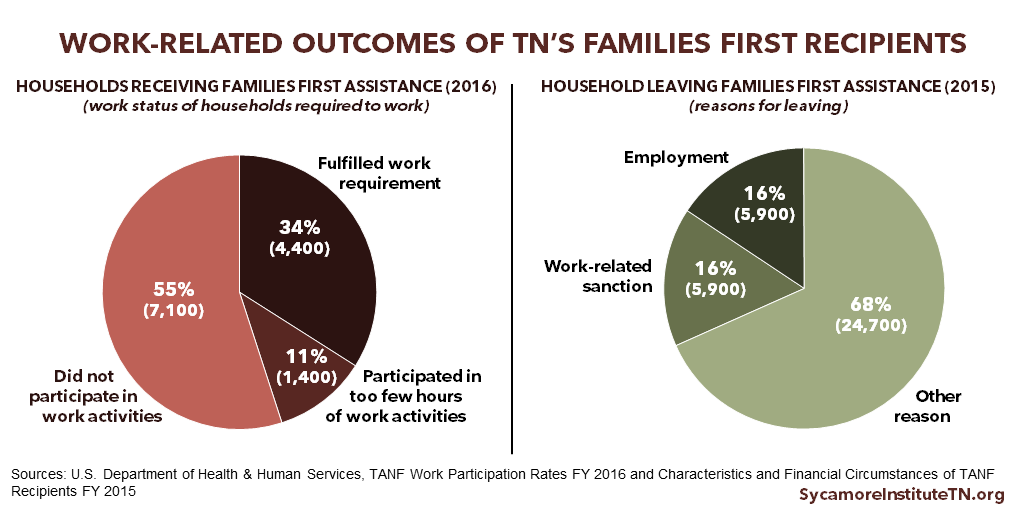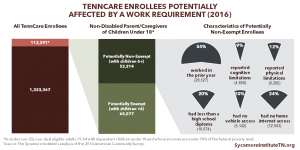
Key Takeaways
- The Families First work requirement combines benefit sanctions and time limits with support services to both incentivize and aid employment among certain program recipients.
- Families First has consistently met federal work participation rate targets. However, federal data may provide an incomplete picture of the number of recipients engaged in work-related activities.
- Over the longer term, Families First has helped some recipients find employment, but their wages are often below the poverty level. Some former recipients may need additional help to become self-sufficient.
- Implementing work requirements and support services in Families First took significant effort and funding.
The Trump administration has opened the door to letting states require some Medicaid enrollees to work or engage in work-related activities. This report analyzes Tennessee’s experience with welfare-to-work and summarizes TennCare’s new Employment and Community First (ECF) CHOICES program.
Part 1 in this series examined recent proposals for Medicaid work requirements from other states, their policy rationale, and the populations most likely to be affected if implemented in Tennessee. Part 3 will summarize key points to consider if TennCare explores a potential work requirement. Together, these reports seek to help interested parties weigh the trade-offs of a Medicaid work requirement. Get the whole 3-part series here.
What Is Welfare-To-Work?
“Welfare-to-work” programs aim to transition enrollees from public assistance to self-sufficiency through participation in the labor market. To receive benefits, specified enrollees must typically work or engage in activities like job search, training, or education. An example of an existing welfare-to-work program in Tennessee is Families First.
Families First and Its Work Requirement
Tennessee policymakers thinking about adding a work requirement to TennCare may look to the state’s experience with Families First, our Temporary Assistance for Needy Families (TANF) program. Implemented in 1996 under President Bill Clinton and Governor Don Sundquist, Families First represented a shift in focus from pure cash welfare to supporting “work, personal responsibility, and parenting” for welfare recipients. (1) The state describes Families First as “a workforce development and employment program” that “is temporary and has a primary focus on gaining self-sufficiency through employment.” (2)
This report analyzes 3 primary questions about Tennessee’s TANF program. The information below summarizes the key findings for each question. More information on each of these topics is included in the Appendix.
1) How Is the Families First Work Requirement Structured?
The Families First work requirement combines benefit sanctions and time limits with wrap-around services to both incentivize and support employment among certain program recipients.
In 2016, 42% of Families First recipients were subject to a work requirement under federal law. (3) Some groups of recipients are explicitly excluded from the work requirement by law. All other recipients must meet work requirements after 24 months or when the state deems them ready for work — whichever comes first.
Most Families First recipients subject to work requirements must participate in 30 hours of work activities per week. Eligible activities include not only employment but also activities like training and job search.
When calculating eligibility, Families First disregards some income earned from work to help individuals transition to work without affecting their benefit amount or eligibility (sometimes referred to as the “benefit cliff”). Governor Haslam in 2017 proposed adding a transition period for recipients whose income from work exceeds program limits. (4)
In addition to cash assistance, Families First provides support services to help recipients find employment and gain self-sufficiency. These services include transportation, child care assistance, job training, and more and account for about 2/3 of the Families First budget.
2) What Are the Employment Outcomes for Families First Recipients?
Our analysis relies on federal program data, which are publicly available and consistently collected over time, but these data have limitations. For example, states and the federal government may have different definitions of what should count as work activities and who should be exempt from them. Because of this tension, the underlying definition of who and what counted towards meeting federal targets changed for Tennessee in 2007 — limiting the ability to make meaningful comparisons of the data over time.
Since the inception of the work requirement, Tennessee has consistently met federal targets for work participation. (5) The federal government holds each state to a state-specific target for the share of families that must participate in work activities.
Figure 1
34% of non-exempt Families First households in 2016, (or 4,400 households) fulfilled the federal work requirement in Tennessee. Another 11% participated in work activities but did not meet the required number of hours. (3) The earnings of working Families First recipients have generally hovered around 60% of the poverty level for a family of 3. (6) (7)
16% of Families First households that left the program in 2015 did so for employment, and another 16% left because they failed to meet work requirements. The remainder left for other reasons. (8)
Evaluating long-term outcomes for TANF recipients is difficult. Tennessee-specific studies have found some improvements in the economic well-being of former Families First recipients who work but many continue to fall below the poverty level. (9) (10) Other national studies have found that employment increased following enactment of work requirements, but former TANF recipients struggle to keep jobs, face stagnant wages, and need additional help to become self-sufficient. (11) (12) (13)
3) How Was the Families First Work Requirement Initially Implemented?
The implementation of Families First in 1996 required significant effort and funding. Implementing the program and its work requirement involved additional spending, new state law and regulations, and more local coordination. For example, recurring state and federal funding in Tennessee’s budget grew by more than $70 million in FY 1996-1997 to implement the program.
Do Lessons from Families First Apply To TennCare?
Families First may provide some insights to help weigh a potential TennCare work requirement, but there are limitations to their applicability due to the differences in the programs. In general, the two cases have some similarities because the Families First experience involved integrating a work component by reforming an existing program, as would be the case for TennCare. At the same time, however, TANF and Medicaid have important differences.
- Program Goals: The transition to Families First represented a fundamental shift in the goals of the welfare program. Under the 1996 reforms and implementation of the work requirement, the goal of what is now Families First became to help low-income families gain self-sufficiency through employment. TennCare’s focus is providing access to health care for certain low-income Tennesseans who may not be able to afford or access private insurance.
- Income Eligibility: TANF eligibility is limited to families and caregivers of children with incomes just above the federal poverty level (e.g. no more than $23,600/ year for a family of 3). (14) TennCare eligibility for adults largely depends on factors like age, pregnancy, and disability status in addition to income. For example, pregnant women must have household incomes below 195% of poverty (about $39,800 for a household of 3) to qualify for TennCare. Meanwhile, adults serving as family caregivers have lower income limits for TennCare than TANF. (15)
- Enrollment and Intake Process: Families First applicants are required to complete both an application and an in-person interview with a caseworker to determine eligibility and household-specific needs. TennCare enrollment is largely automated through healthcare.gov and does not require an in-person interview.
- Program Size: Families First served just over 56,000 Tennesseans in June 2017, including about 12,000 adults. (16) In the same month, TennCare enrollment exceeded 1.4 million. (17)
- Duration: The implementation of Families First involved instituting a time limit for benefits. Individuals are limited to 60 months of Families First benefits throughout their lifetimes. TennCare has no similar limit.
- Support Services: Although Families First is often thought of as a cash assistance program, it often serves as an entry point to other support services like child care, transportation, and nutrition assistance that may be more valuable to recipients. The delivery of these diverse services requires significant case management to administer and track progress towards employment goals. TennCare does not currently provide this level of case management.
TennCare’s Employment and Community First CHOICES Program
TennCare’s new Employment and Community First (ECF) CHOICES program includes a supported work component, but without more data, it may be difficult to draw insights for broader TennCare work-related activities. Launched in 2016, ECF CHOICES aims to help Tennesseans with an intellectual or developmental disability (ID/DD) “live as independently as possible at home or in the community.” (18) Early data on enrollees’ experiences are not yet available, and it is too soon to get data on long-term outcomes for employment, independence, and consumer and family satisfaction. As the program continues to develop, additional analysis will be possible.
Enrollees in ECF CHOICES must be interested in working or open to exploring the option of employment. The program combines coverage for health care and home- and community-based long-term services and supports with efforts to help enrollees find and keep employment. (19) (20) ECF CHOICES offers 14 distinct employment services and supports, including:
- Help with job development plans
- Job coaching
- Vocational training
- Opportunities to try out different jobs
- Career advancement services(19) (21)
Services also include benefits counseling to help enrollees understand how new income could impact their eligibility for TennCare and other programs. Private health insurance companies that contract with TennCare (known as managed care organizations or MCOs) coordinate all services.
Developing and implementing ECF CHOICES took several years. TennCare began working with stakeholders and planning for the program as early as 2013, and enrollment opened on July 1, 2016 to about 1,700 people.
Parting Words
Tennessee policymakers weighing the trade-offs of adding a work requirement to TennCare may look for insights in Tennessee’s prior experience with welfare-to-work. Tennessee’s Families First experience may hold important lessons, but the differences should also be understood.
The information above supplements an earlier report examining Medicaid work requirement proposals, their policy rationale, and the populations most likely to be affected if implemented in Tennessee. The third installment in this series will summarize key points for policymakers to consider regarding a potential TennCare work requirement. Get the whole 3-part series here.
References
Click to Open/Close
- Rudolph, Linda and O’Hara, Michael. Families First: Landmark Transition. Bureau of Business and Economic Research, Center for Manpower Studies, The University of Memphis. [Online] December 2002. https://www.tn.gov/assets/entities/humanservices/attachments/ff-transition.pdf.
- Tennessee Department of Human Services. Families First. [Online] [Cited: August 31, 2017.] https://www.tn.gov/humanservices/topic/families-first-tanf.
- U.S. Department of Health and Human Services. TANF Work Participation Rates – FY 2016 (Tables 3A and 8A). Administration for Children and Families, Office of Family Assistance. [Online] September 7, 2017. https://www.acf.hhs.gov/ofa/resource/work-participation-rates-fiscal-year-2016.
- State of Tennessee. Haslam, Barnes Announce Plans To Reform Welfare Programs to Encourage Self-Sufficiency And Program Integrity. [Online] September 18, 2017. https://www.tn.gov/humanservices/news/2017/9/18/haslam-barnes-announce-plans-to-reform-welfare-programs-press-release.html
- U.S. Department of Health & Human Services. Work Participation Rates – FY 1997-FY 2016 (Table 1A). Administration for Children and Families, Office of Family Assistance. [Online] https://www.acf.hhs.gov/ofa/resource-library/search?area%5B2377%5D=2377&topic%5B2357%5D=2357#?area%5B2377%5D=2377&topic%5B2357%5D=2357&sort=relevant.
- U.S. Department of Health and Human Services. Characteristics and Financial Circumstances of TANF Recipients – FY 1997-FY 2015 (Table 20 for FY97, Table 21 for FY98-FY99), Table I-39 for FY00, Table 45 for FY01-FY12, Table 40 for FY13-FY15). Administration for Children and Families, Office of Family Assistance. [Online] Access via https://www.acf.hhs.gov/ofa/resource-library/search?area%5B2377%5D=2377&topic%5B2353%5D=2353.
- U.S. Census Bureau. Poverty Thresholds. [Online] https://www.census.gov/data/tables/time-series/demo/income-poverty/historical-poverty-thresholds.html.
- U.S. Department of Health and Human Services. Characteristics and Financial Circumstances of TANF Recipients – FY 2015 (Table 43). Administration for Children and Families, Office of Family Assistance. [Online] August 2016. https://www.acf.hhs.gov/ofa/resource/characteristics-and-financial-circumstances-of-tanf-recipients-fiscal-year-2015.
- Kiser, Brad and Bruce, Donald. Post-Program Experience of Families First Participants. Center for Business and Economic Research, College of Business Administration, The University of Tennessee. [Online] June 2005. [Cited: November 28, 2017.] http://cber.haslam.utk.edu/TDHS/ffjun0502.pdf.
- Perkins, Godwin Deborah and Homer, Karen. Welfare Leavers in Tennessee: For Better or for Worse? [Online] September 2002. https://www.tn.gov/assets/entities/humanservices/attachments/welfare-leavers2002.pdf.
- Hamilton, Gayle. Improving Employment and Earnings for TANF Recipients. Urban Institute. [Online] March 2012. http://www.mdrc.org/sites/default/files/Improving%20Employment%20nd%20Earnings%20for%20TANF%20Recipients.pdf.
- Miller, Cynthia. Leavers, Stayers, and Cyclers: An Analysis of the Welfare Caseload. Manpower Demonstration Research Corporation. [Online] November 2002. https://aspe.hhs.gov/system/files/pdf/72671/Miller-MDRC-02.pdf.
- MACPAC. Work as a Condition of Medicaid Eligibility: Key Take-Aways from TANF. [Online] October 2017. [Cited: November 30, 2017.] https://www.macpac.gov/wp-content/uploads/2017/10/Work-as-a-Condition-of-Medicaid-Eligibility-Key-Take-Aways-from-TANF.pdf.
- Benefits.gov. Tennessee Families First Program Requirements. [Online] https://www.benefits.gov/benefits/benefit-details/1678.
- Tennessee Division of Health Care Finance and Administration. TennCare Eligiblity Reference Guide. [Online] https://www.tn.gov/assets/entities/tenncare/attachments/eligibilityrefguide.pdf.
- Tennessee Department of Human Services. Families First in Numbers: Updated Information from June 2017. [Online] https://www.tn.gov/assets/entities/humanservices/attachments/FF_in_Numbers_2017_06_June.pdf.
- Tennessee Division of Health Care Finance and Administration. TennCare Enrollment Report for June 2017. [Online] https://tn.gov/assets/entities/tenncare/attachments/fte_201706.pdf.
- State of Tennessee. Employment and Community First CHOICES. Division of TennCare. [Online] https://www.tn.gov/tenncare/long-term-services-supports/employment-and-community-first-choices.html.
- Tennessee Division of Health Care Finance and Administration. Introduction to Employment and Community First CHOICES. [Online] 2016. https://www.tn.gov/assets/entities/tenncare/attachments/introductionToEcfChoices.pdf.
- —. De-Bunking Myths about Employment and Community First CHOICES. [Online] 2016. https://www.tn.gov/assets/entities/tenncare/attachments/Myths.pdf.
- —. ECF CHOICES Member Benefit Table. [Online] 2017. https://www.tn.gov/assets/entities/tenncare/attachments/MemberBenefitTable.pdf#page=2.


















